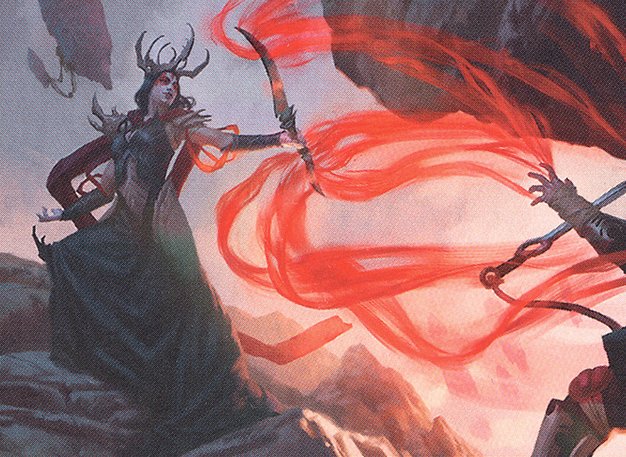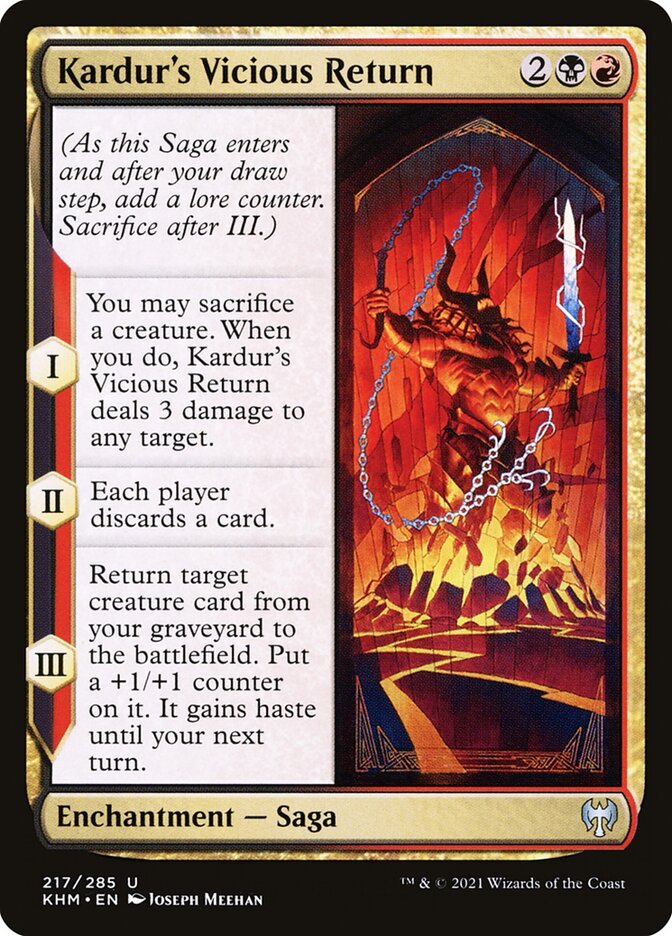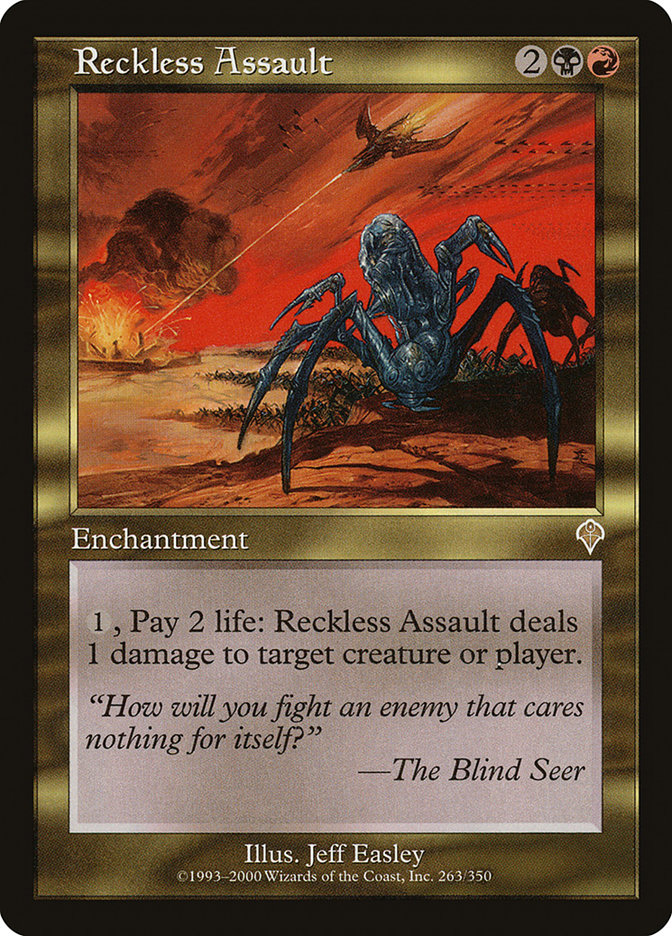Kardur's Vicious Return MTG Card
| Mana cost | |
| Converted mana cost | 4 |
| Rarity | Uncommon |
| Type | Enchantment — Saga |
| Released | 2021-02-05 |
| Set symbol | |
| Set name | Kaldheim |
| Set code | KHM |
| Number | 217 |
| Frame | 2015 |
| Layout | Saga |
| Border | Black |
| Illustred by | Joseph Meehan |
Text of card
(As this Saga enters and after your draw step, add a lore counter. Sacrifice after III.) I — You may sacrifice a creature. When you do, Kardur's Vicious Return deals 3 damage to any target. II — Each player discards a card. III — Return target creature card from your graveyard to the battlefield. Put a +1/+1 counter on it. It gains haste until your next turn.
Cards like Kardur's Vicious Return
Kardur’s Vicious Return is an intriguing sorcery that brings a lot to the table in Magic: The Gathering. It’s reminiscent of the card revival ability of Unearth, which also grants the reanimation of a creature for a turn. Kardur’s Vicious Return differs by allowing not just an instant bask in resurrection rush but also provides additional benefits over the next few turns, thanks to its saga structure.
Comparably, the card Claim // Fame offers a two-part revival with an initial creature return followed by a potential power boost. This card diverges from Kardur’s Vicious Return, which delivers a cumulative effect over multiple turns and includes the option to toss in a sacrifice for a direct damage bonus. Then there’s Bond of Revival, which presents a straightforward reanimation strategy with a speed boost for the creature. However, unlike Kardur’s Vicious Return, it lacks the incremental advantages and board impact through subsequent turns.
When placed side by side with its cousins in the creature recovery arena, Kardur’s Vicious Return carves its niche in MTG. Its multifaceted saga format gives players strategic depth and adds layers of value to the game, making it a distinctive choice in deck construction.
Cards similar to Kardur's Vicious Return by color, type and mana cost
Decks using this card
MTG decks using Kardur's Vicious Return. Dig deeper into the strategy of decks, sideboard cards, list ideas and export to play in ARENA or MOL.
| # | Name | Format | Archetype | Event |
|---|---|---|---|---|
 | Rakdos Midrange | Pioneer | Rakdos Midrange | Peasant Pioneer Showdown - A Josh and Pat's MTG Bazaar Sponsored Event |
Card Pros
Card Advantage: Kardur’s Vicious Return allows players to return a creature card from their graveyard to the battlefield. This reanimation ability offers a significant edge by utilizing resources that typically remain untapped once in the graveyard.
Resource Acceleration: By enabling players to sacrifice a creature, which could potentially trigger beneficial ‘on death’ effects, Kardur’s Vicious Return paves the way for strategic plays. It accelerates resource usage by morphing potential losses into valuable plays.
Instant Speed: While not at instant speed itself, Kardur’s Vicious Return can be set up to work in synergy with flash creatures and instant-speed sacrifice outlets. It increases the potential for unexpected and potent interactions during your own or your opponent’s turn.
Card Cons
Discard Requirement: Kardur’s Vicious Return imposes a discard condition upon casting, which may not always align with your hand management strategy. Letting go of valuable cards can be especially taxing when your hand is already dwindling.
Specific Mana Cost: The casting cost includes both black and red mana, which necessitates a dedicated color commitment. This cost constrains the card to specific archetypes, barring it from more varied mana bases.
Comparatively High Mana Cost: With a mana value of four, Kardur’s Vicious Return competes with numerous other impactful plays in the same cost bracket. Players may find themselves prioritizing other options that provide immediate board presence or advantage.
Reasons to Include Kardur’s Vicious Return in Your Collection
Versatility: Kardur’s Vicious Return is a flexible saga card that can easily slide into multiple deck architectures. With the ability to return a creature from the graveyard to the battlefield on its final chapter, it fits well within strategies that are based on creature recursion or sacrifice.
Combo Potential: This card offers synergistic possibilities, especially in decks that capitalize on “enters the battlefield” or “dies” triggers. Its first and second chapters, which deal damage and force each player to discard a card, can also be leveraged in combo setups aiming for disruption and graveyard setup.
Meta-Relevance: The current game environment, where graveyard manipulation and controlling the board state are essential, makes Kardur’s Vicious Return a relevant addition to many decks. It is particularly potent in meta-games where grinding out value over the course of a few turns can pivot the tide of battle in your favor.
How to beat
Kardur’s Vicious Return is a saga card that stands out in the MTG realm due to its multiple-phase utility. During its first two chapters, it allows players to cast creatures from their graveyards for a reduced mana cost, ultimately leading to a significant board presence. However, the third chapter poses a substantial threat by potentially annihilating the weakest creature and dealing 3 damage to each opponent. To effectively combat Kardur’s Vicious Return, swift removal of the saga before it reaches its final chapter is key.
One could consider incorporating instant-speed enchantment removal into their deck to disrupt this saga’s narrative. Cards like Disenchant or Naturalize offer a cost-effective solution to dispose of Kardur’s Vicious Return prematurely. Additionally, graveyard hate cards such as Grafdigger’s Cage can suppress the saga’s reanimation ability, curtailing its impact on the board and preserving your battlefield position. It’s vital to monitor the saga’s progression and employ strategic timing to neutralize this multi-stage threat. Negating Kardur’s Vicious Return before its climax will ensure your creatures remain unscathed, and you stay ahead of your opponents’ strategies.
BurnMana Recommendations
Embark on an epic journey with Kardur’s Vicious Return, a saga that deftly combines resurrection prowess with strategic value plays. Ideal for decks specializing in creature recursion or sacrifice mechanics, this MTG card is a gem for players who relish in manipulating the graveyard to their advantage. Whether it’s enhancing your existing deck’s synergy or seeking to upend the meta with innovative combos, the multifaceted nature of Kardur’s Vicious Return deserves your attention. Dive into our comprehensive insights to adeptly wield this card’s power and carve a path to victory in your next duel.
Where to buy
If you're looking to purchase Kardur's Vicious Return MTG card by a specific set like Kaldheim, there are several reliable options to consider. One of the primary sources is your local game store, where you can often find booster packs, individual cards, and preconstructed decks from current and some past sets. They often offer the added benefit of a community where you can trade with other players.
For a broader inventory, particularly of older sets, online marketplaces like TCGPlayer, Card Kingdom and Card Market offer extensive selections and allow you to search for cards from specific sets. Larger e-commerce platforms like eBay and Amazon also have listings from various sellers, which can be a good place to look for sealed product and rare finds.
Additionally, Magic’s official site often has a store locator and retailer lists for finding Wizards of the Coast licensed products. Remember to check for authenticity and the condition of the cards when purchasing, especially from individual sellers on larger marketplaces.
Below is a list of some store websites where you can buy the Kardur's Vicious Return and other MTG cards:
 BUY NOW
BUY NOW BurnMana is an official partner of TCGPlayer
- eBay
- Card Kingdom
- Card Market
- Star City Games
- CoolStuffInc
- MTG Mint Card
- Hareruya
- Troll and Toad
- ABU Games
- Card Hoarder Magic Online
- MTGO Traders Magic Online
See MTG Products
Legalities
Magic the Gathering formats where Kardur's Vicious Return has restrictions
| Format | Legality |
|---|---|
| Commander | Legal |
| Historic | Legal |
| Legacy | Legal |
| Modern | Legal |
| Oathbreaker | Legal |
| Vintage | Legal |
| Duel | Legal |
| Explorer | Legal |
| Gladiator | Legal |
| Brawl | Legal |
| Pioneer | Legal |
| Timeless | Legal |
Rules and information
The reference guide for Magic: The Gathering Kardur's Vicious Return card rulings provides official rulings, any errata issued, as well as a record of all the functional modifications that have occurred.
| Date | Text |
|---|---|
| 2021-02-05 | A chapter ability doesn’t trigger if a lore counter is put on a Saga that already had a number of lore counters greater than or equal to that chapter’s number. For example, the third lore counter put on a Saga causes the chapter III ability to trigger, but chapters I and II won’t trigger again. |
| 2021-02-05 | As a Saga enters the battlefield, its controller puts a lore counter on it. As your precombat main phase begins (immediately after your draw step), you put another lore counter on each Saga you control. Putting a lore counter on a Saga in either of these ways doesn’t use the stack. |
| 2021-02-05 | Each symbol on the left of a Saga’s text box represents a chapter ability. A chapter ability is a triggered ability that triggers when a lore counter that is put on the Saga causes the number of lore counters on the Saga to become equal to or greater than the ability’s chapter number. Chapter abilities are put onto the stack and may be responded to. |
| 2021-02-05 | If multiple chapter abilities trigger at the same time, their controller puts them on the stack in any order. If any of them require targets, those targets are chosen as you put the abilities on the stack, before any of those abilities resolve. |
| 2021-02-05 | Once a chapter ability has triggered, the ability on the stack won’t be affected if the Saga gains or loses counters, or if it leaves the battlefield. |
| 2021-02-05 | Once the number of lore counters on a Saga is greater than or equal to the greatest number among its chapter abilities, the Saga’s controller sacrifices it as soon as its chapter ability has left the stack, most likely by resolving or being countered. This state-based action doesn’t use the stack. |
| 2021-02-05 | Removing lore counters won’t cause a previous chapter ability to trigger. If lore counters are removed from a Saga, the appropriate chapter abilities will trigger again when the Saga receives more lore counters. |








